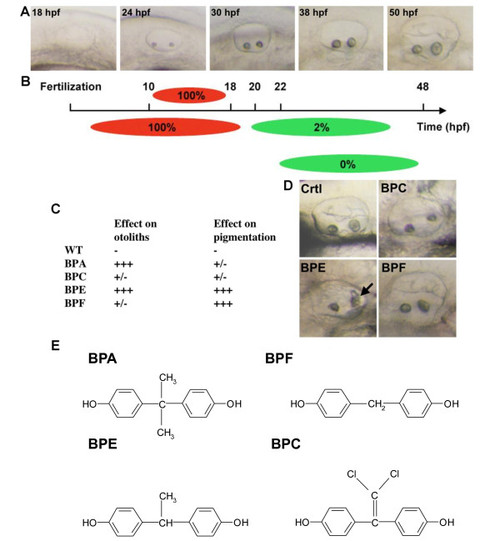Fig. 2
- ID
- ZDB-FIG-150520-18
- Publication
- Gibert et al., 2011 - Bisphenol A induces otolith malformations during vertebrate embryogenesis
- Other Figures
- All Figure Page
- Back to All Figure Page
|
Bisphenol effects are time and compound specific. A: Live pictures of the developing otic vesicle from 18 to 50 hpf in zebrafish embryo. B: BPA affects otolith in a restricted time window. Diagram showing the effect of 70 µM BPA treatments with different starting points or length of exposure. Upper panel: BPA pulse treatments (red bars) were performed from 10 hpf. At different stage of development (18, 24, 30 and 38 hpf) embryos were washed and developed in BPA free medium (gray bars). Otic vesicles were scored at 50 hpf. Lower panel: BPA acts prior 22 hpf to induce otolith defects. Treatments started prior or at 18 hpf lead to 100% of otolith defects. Treatment started from 20 hpf onwards lead to 85% of embryos with otolith defect. Treatment started at 22 hpf lead to only 2% of affected embryos. Treatments started later did not lead to any otolith defect. Red bars represent time when embryos were exposed to BPA. Gray bars represent time when embryos were not exposed to this compound. C: Various bisphenols affect otolith development and/or pigmentation. Embryos were treated from 5 to 72 hpf and malformed otolith or pigmentation defects scored (+++ indicates maximum defect, i.e. malformed otolith or total lack of pigment). Treatment of embryos with either BPA (70 µM) or BPE (70 µM) resulted in malformed otoliths. BPE also affected pigmentation, as did BPF (50 µM). BPC (70 µM) was without clear effects in these assays. D: Pictures of the effect of BPC, BPE and BPF on otolith development. All embryos were exposed to 70 µM of bisphenol. Note that only BPE gives an otolith phenotype similar to what in observed in BPA treated embryos with otolith aggregates marked by a black arrow. E: Chemical structures of BPA, BPC, BPE and BPF. |

